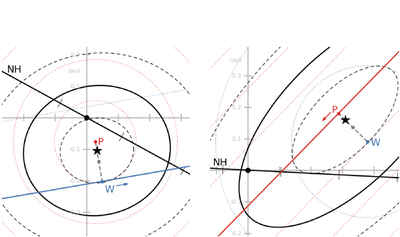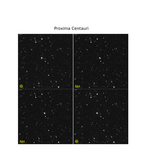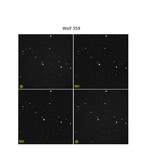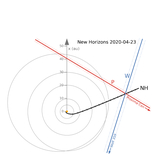Image Details

Caption: Figure 4.
The lines of position for Proxima Cen (P) and Wolf 359 (W) covering the area of space where they both pass by New Horizons, viewed from two directions. The small arrows near the P and W labels indicate the direction to the given star. The left view looks in the observed direction to Proxima Cen; the right view is the same for Wolf 359. NH marks the true trajectory of New Horizons. Tick marks are at 30 day intervals; the spacecraft moves right to left in both views. The gray axes with ticks at 0.1 au intervals intersect at the true position of New Horizons on 2020 April 23. The ticks bracketing this point are April 5 and May 5, respectively. The P and W lines do not intersect; the points of closest approach of the two lines are connected by the dashed gray line, which lies in the plane in both views (the positive ecliptic latitude is up in both views). The P and W lines are 0.133 au apart at the closest approach. The midpoint of the dashed connecting line is indicated by a gray dot. The most likely spacecraft position x from Equation (9) is indicated by the black star. It is 0.351 au from the true spacecraft position indicated by the black dot. The faint dotted lines are nested cylinders around the P and W lines corresponding to steps of ﹩0\mathop{.}\limits^{^{\prime\prime} }1﹩ in the observed direction. The solid ellipses are the 1σ error ellipses from Equation (12) assuming ﹩{\sigma }_{\alpha }=0\mathop{.}\limits^{^{\prime\prime} }44﹩ for each individual LORRI image; the dashed ellipses are 0.5σ and 1.5σ. The spacecraft is at 0.94σ.
Copyright and Terms & Conditions
© 2025. The Author(s). Published by the American Astronomical Society.






